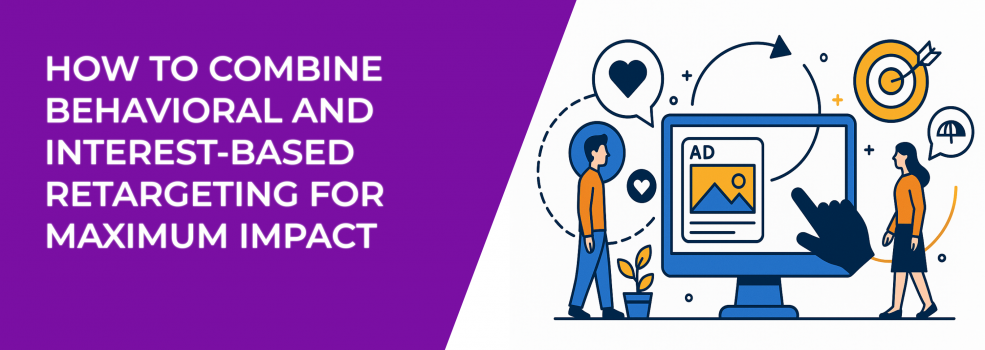Let’s be honest — Facebook and Instagram ads are no longer the free-for-all playgrounds they used to be. Targeting has become tighter. Competition is relentless. And users? They're savvier than ever.
But if you're running ads and not blending behavioral and interest-based retargeting, you're leaving money on the table.
This isn’t about jumping on the latest trend. It’s about strategically layering your data to reach the right people, at the right moment, with the right message. So, how do you do that?
Let’s dig in.
Why combine behavioral and interest-based retargeting?
Retargeting, in itself, is powerful. But retargeting based on a single dimension — like just behavior or just interests — can limit your results. Facebook and Instagram users aren’t one-dimensional, and your retargeting strategy shouldn’t be either.
Behavioral retargeting looks at users' actions: how long they stayed on your site, whether they engaged with your video, clicked on a carousel, or added something to a cart. These behaviors suggest intent. They’re signals that someone might be closer to converting than a cold audience.
On the other hand, interest-based targeting casts a wider net. It uses user profiles, page likes, content engagement, and browsing patterns to infer passions, hobbies, and lifestyle choices. These interests tell you why someone might care about your product.
So what happens when you combine the two?
You create micro-audiences that reflect both who a person is and what they’ve done. This lets you craft messaging that feels more personal and timely — because it is.
Tip: start simple. Create a custom audience of people who visited your pricing page and layer it with an interest like “startup tools” or “solopreneurship.” You’ll likely see better CTRs than either audience alone.
The power of layered targeting
Combining these strategies gives you more granularity — and that leads to more control.
Let’s break that down.
Imagine you're selling eco-friendly cookware. You’ve got two users:
-
One watched 90% of your product demo video.
-
The other liked several pages about sustainable living and healthy cooking.
Individually, each user is valuable. But the overlap? That’s your hot zone. Someone who did something (watch the demo) and also cares about what you stand for (sustainability) is more likely to convert — if the message matches.
This is where layered targeting outperforms traditional segmentation.
Instead of blasting everyone who’s ever looked at your homepage, you’re now refining the audience down to people who took meaningful actions and align with your brand values or niche.
Tip: use Facebook’s “Narrow Further” option when creating ad sets. This lets you say: “People who visited my product page” AND “are interested in X.” It’s a subtle shift that can dramatically improve ad relevance.
Want a deeper walkthrough of how to structure layered audiences? This guide on layering detailed targeting is a must-read for advanced segmentation.
Build segments that match intent and motivation
Here’s where nuance matters.
Let’s say someone visits your site three times in one week. That alone tells you something. But what if they’re also actively engaging with Instagram content around productivity, digital tools, or wellness? Now you know more than just intent — you understand motivation.
And motivation shapes how you speak to them.
For example, if you're promoting an online course:
-
A user who read two blog posts and clicked your syllabus might be in research mode — serve an ad with testimonials and case studies.
-
Another user who stayed on your pricing page for 4 minutes and follows pages like “Remote Work Life” or “Digital Nomads” may be evaluating ROI — offer a timed discount or flexible payment plan.
This approach makes your retargeting less robotic. You’re not just saying “Hey, you were here before.” You’re saying, “I know why you’re here and here’s something that’ll help.”
Tips: use video view percentages as behavior filters. Someone who watched 50% or more is typically more engaged. Also, interests like “freelancing,” “small business,” or “email marketing” are great for B2B products, especially when layered with in-app behaviors.
Don't over-rely on interest buckets
Interest-based targeting alone isn’t the powerhouse it used to be.
Meta has slowly phased out many interest categories due to privacy changes. What’s left is less precise — and more competitive.
Many advertisers still default to targeting interests like “online shopping” or “fitness.” But these broad buckets often include people who engaged years ago, or only marginally. It’s not uncommon to see campaigns that burn through budgets without enough quality clicks.
So while interests should absolutely be part of your mix, treat them as a signal, not a guarantee.
Use them to add depth — not to define your entire campaign.
Tip: create overlapping audiences in Ads Manager to test combinations. For example:
-
Test “Visited site in last 7 days + interested in wellness”.
-
Against “Visited site in last 7 days” alone.
You’ll get hard data on how interest layering affects results.
For a smarter approach to interest targeting, check out the 2025 Guide to Facebook Interest Targeting for B2C Brands.
Experiment with exclusions and frequency
Combining behavioral and interest-based signals opens up more sophisticated audience controls — especially when it comes to exclusions.
Let’s say someone purchased your product. Do you really want to show them the same ad again? Not unless it’s for a cross-sell or loyalty offer.
You can go even deeper:
-
Exclude users who bounced after under 5 seconds — low intent.
-
Exclude those who already signed up for your webinar — shift them to a nurture sequence.
-
Exclude people who have an interest in high-end fashion from seeing a budget-focused campaign.
This keeps your campaigns lean, your CPMs healthy, and your ads relevant.
Tips: use Facebook’s “Exclude Custom Audience” function aggressively. It’s one of the most underused features by small business advertisers. Also, rotate creative every 7–10 days for warm audiences to avoid ad fatigue. Frequency over 3? Watch for CPC and CTR drops.
If you’re not using exclusions effectively, you might be wasting ad spend — here’s how to use exclusion targeting strategically.
Use Lookalikes with caution and precision
Lookalikes are often touted as a “set it and forget it” solution — but in a hybrid strategy, they require more finesse.
If you’re building lookalikes off of all visitors, you’re including everyone from the curious to the uninterested. That dilutes quality.
Instead, build your lookalike audiences from behavior plus interest criteria:
-
People who added to cart and engaged with sustainability content.
-
Users who viewed 3+ pages and follow entrepreneur-related pages.
These audiences are smaller but they’re richer in intent. And that leads to better performance when scaled.
Tips: test multiple lookalike percentages. A 1% might work best for high-ticket products, while 3% can scale better for impulse buys.
Don't forget to refresh your seed audiences monthly. That ensures you’re building lookalikes based on current user behavior and trends.
Curious when to use a lookalike audience versus a custom one? This comparison breaks down the strengths and use cases for each.
Key takeaways
-
Behavioral data tells you what users are doing — use it to identify intent.
-
Interest data tells you what users care about — use it to refine messaging.
-
Combine both to create smarter segments and more relevant ads.
-
Use exclusions to fine-tune who sees what — and when.
-
Lookalike audiences are only as good as the seed data behind them.
Precision targeting is no longer optional — it’s the price of entry.
Final thoughts
In an era where attention spans are short and platforms are crowded, lazy retargeting won’t cut it.
Combining behavioral and interest-based retargeting isn’t just a smart tactic — it’s fast becoming a necessity. It helps you get closer to your ideal customer, not just demographically, but psychologically.
This approach doesn’t just improve CTRs or lower your CPA. It makes your ads feel less like ads — and more like helpful, timely nudges.
So ask yourself: are you building real connections through data-driven relevance?
You’ve got the tools. You’ve got the traffic. Now it’s time to meet your audience where they are and where they’re headed.

